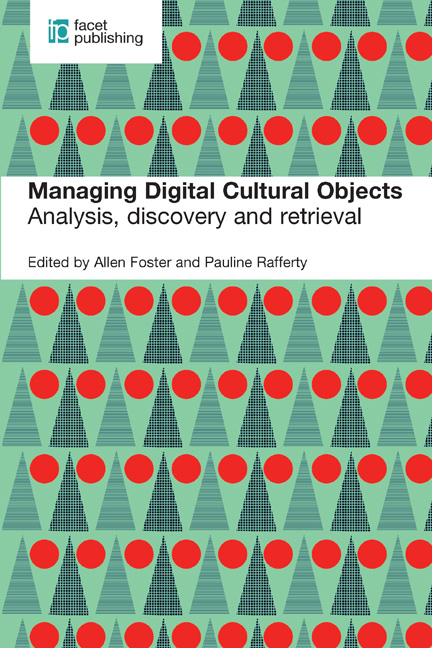Book contents
- Frontmatter
- Contents
- List of figures and tables
- Contributors
- Introduction
- PART 1 ANALYSIS AND RETRIEVAL OF DIGITAL CULTURAL OBJECTS
- PART 2 DIGITIZATION PROJECTS IN LIBRARIES, ARCHIVES AND MUSEUMS: CASE STUDIES
- PART 3 SOCIAL NETWORKING AND DIGITAL CULTURAL OBJECTS
- 7 Photos: Flickr, Facebook and other social networking sites
- 8 Searching and classifying affinities in a web music collection
- 9 Film retrieval on the web: sharing, naming, access and discovery
- Index
7 - Photos: Flickr, Facebook and other social networking sites
from PART 3 - SOCIAL NETWORKING AND DIGITAL CULTURAL OBJECTS
Published online by Cambridge University Press: 09 June 2018
- Frontmatter
- Contents
- List of figures and tables
- Contributors
- Introduction
- PART 1 ANALYSIS AND RETRIEVAL OF DIGITAL CULTURAL OBJECTS
- PART 2 DIGITIZATION PROJECTS IN LIBRARIES, ARCHIVES AND MUSEUMS: CASE STUDIES
- PART 3 SOCIAL NETWORKING AND DIGITAL CULTURAL OBJECTS
- 7 Photos: Flickr, Facebook and other social networking sites
- 8 Searching and classifying affinities in a web music collection
- 9 Film retrieval on the web: sharing, naming, access and discovery
- Index
Summary
Introduction
With effective and widely accessible image creation, storage and distribution technologies, digital images have become ubiquitous, woven into our daily lives in ways unimaginable a century ago. The web's current range of image hosting sites – from curated collections in museums and archives, to websites aggregating personal or group collections (Flickr), to an organization's collections or collections of specific interest, or where images are ‘simply’ an added form of communication, sharing events, ideas or everyday life (Facebook, Instagram, Twitter, Tumblr) – forms a worldwide anytime resource of unprecedented size for image participation and immersion. Images have become information resources used for a variety of endeavours, ranging from teaching and research to national security, or the object of leisure activities such as games (the ESP game) and shopping.
The digital age principles of interactivity (dynamic, user-controlled, nonlinear, complex information behaviour), connectivity (sense of community, construction of social worlds) and access (breaking longstanding information barriers) (Dresang, 2005, 183–90) interact to create what we now call the social web, where people find and create content, form communities where new and diverse perspectives can emerge, and interact with content and each other to create new content such as ‘tags’, comments and ratings. Lew (2001, vii) notes the extent of the transform - ation: ‘Digital visual information is here to stay. The major world nations are converting their cultural heritage into digital libraries…. Visual information permeates every facet of our life in the twenty-first century. Finding it is the next step.’ The production and use of social media sites themselves change the nature of the search process and its products. Social sharing sites complement traditional and digital libraries but also differ from them in important ways and introduce new issues, having multiple entry points, from user-supplied description to more traditional indexing. In social media searching there are few rules, often only requiring entering terms in an empty search box. What does remain constant across all these is a need for users to understand the nature of the descriptive ‘vocabularies’ used in these systems, where they come from, what motivates their creation, the collections they spring from, and the search goals they may fulfil.
- Type
- Chapter
- Information
- Managing Digital Cultural ObjectsAnalysis, discovery and retrieval, pp. 143 - 182Publisher: FacetPrint publication year: 2016



